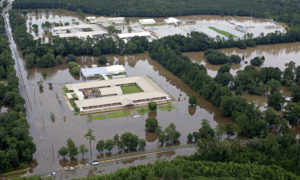The National Association of Insurance Commissioners (NAIC) has released its recommendations for changes to the National Flood Insurance Program (NFIP) when it goes up before Congress for reauthorization next year.
The current NFIP is due to expire on Sept. 30, 2017. Critics of the program, including many state insurance departments, have insisted that changes must be made to in order for the NFIP to remain viable. FEMA said in 2015 it has plans for “sweeping reform” of the program, which is currently more than $23 billion in debt. More than 5.1 million consumers and businesses around the country utilize the program.

“Congress will have to tackle the tension between risk based pricing practices and affordable rates,” NAIC Property & Casualty Committee wrote in its draft recommendation to the Government Relations Leadership Council. “As Congress wrestles how to address these challenges, state insurance regulators stand ready to assist.”
NAIC urged Congress to consider its recommendations as part of a comprehensive approach to address the nation’s flood risk. The changes include:
- Support a long-term reauthorization of the NFIP to avoid short- term extensions and program lapses that create uncertainty in both the insurance and housing markets. Reauthorization should be for a minimum of 10 years.
- Encourage greater growth in the private flood insurance market as a complement to the NFIP to help provide consumers with more choices.
- Support passage of the Flood Insurance Market Parity and Modernization Act (HR 2901/S 1679) that clarifies private flood insurance meets the mandatory purchase requirement; that state insurance regulators have the same authority and discretion to regulate private flood insurance as they have with other similar insurance products; and that private flood insurance meets the continuous coverage requirement so policyholders will not lose any subsidy they previously had with the NFIP if they choose to return.
- Require FEMA to reinstate its prior rules allowing policyholders to cancel their NFIP policy mid-term and receive a refund on a pro-rated basis if they decide to replace their NFIP policy with a private flood insurance policy.
- Require FEMA to share NFIP claims data with insurers and modelers in order for the private market to be able to accurately assess flood risks.
- Require FEMA to eliminate the non-compete clause to allow the Write Your Own (WYO) insurance companies to sell stand-alone private flood insurance outside of the NFIP.
- Require FEMA to consult with state insurance regulators on training for insurance producers that sell NFIP policies to ensure consistency with training requirements for insurance producers that sell private flood insurance policies.
- Encourage support for mitigation planning, including legislative efforts such as the Disaster Savings Accounts Act (HR 2230) to allow individuals to set aside funds in a tax-preferred savings account for disaster mitigation and recovery expenses.
- Consider changes to the tax code to allow insurers to establish tax-deferred pre-event reserves to fund catastrophe losses.
- Require FEMA to provide increased transparency to all stakeholders regarding its decision-making process for developing and updating its flood maps.
- Encourage a coordinated effort between the public and private sector to increase overall take up rates of flood insurance, including facilitating opportunities to educate consumers about flood insurance policy options. Explore methods to ensure better compliance with the mandatory purchase requirement and encourage the purchase of flood insurance for those outside of special flood hazard areas.
- Encourage careful consideration of affordability issues and the impact of NFIP policy changes on current NFIP policyholders. Certain actions should be considered within the reauthorization to address affordability, potentially including continuation by FEMA of its NFIP grandfathering provisions.
- Consider requiring a study on alternative approaches to the flood insurance program structure, including, but not limited to, transitioning the NFIP into a residual market or a reinsurance backstop. The study should include an assessment of the implications of such changes on affordability, availability, the federal budget, taxpayer exposure, and the flood insurance marketplace.
The group plans to discuss the suggested principles at its Aug. 28 meeting in San Diego.
The Property Casualty Insurers Association (PCI) applauded NAIC for its recommendations.
“The recommendations encourage greater growth in the private flood insurance market as a complement to the NFIP to help provide consumers with more choices,” said Don Griffin, vice president, personal lines for PCI. “Developing a strong bipartisan consensus for stable long-term reform in advance of the program’s September 2017 expiration is necessary to avoid lapses and short-term extensions in order to protect families and businesses that depend on flood insurance.”
Was this article valuable?
Here are more articles you may enjoy.



 10 Highest Class-Action Settlements in 2025 Eclipsed $70B Total: Duane Morris
10 Highest Class-Action Settlements in 2025 Eclipsed $70B Total: Duane Morris  Litigation Funding, Other New Laws in SE States Could Impact Liability Insurance
Litigation Funding, Other New Laws in SE States Could Impact Liability Insurance  Disney Worker Injured Trying to Stop Runaway Boulder at Indiana Jones Show
Disney Worker Injured Trying to Stop Runaway Boulder at Indiana Jones Show  AIG’s Zaffino to Step Down as CEO as Aon’s Andersen Steps In
AIG’s Zaffino to Step Down as CEO as Aon’s Andersen Steps In 


